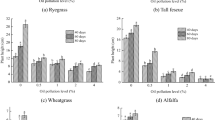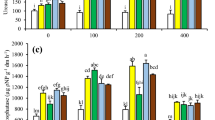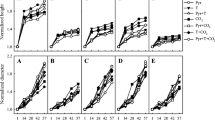Abstract
Key message
Highly tolerant and productive willow cultivars have been identified as potential candidates for phytoremediation of contaminated soil with petroleum hydrocarbons (PHs) in southern Quebec, Canada.
Abstract
Tolerance of Salix to various organic and inorganic contaminants has been well documented and can vary widely among genotypes. In this study, we compared the responses and tolerances of 11 willow cultivars grown in soil contaminated with petroleum hydrocarbons. The study aimed to identify cultivars with the best performance and capacity to establish under these conditions. Using cuttings of the selected willow genotypes, a high-density field experiment was set up on a former industrial site encompassing two distinct sectors: one contaminated (900 m2), and the other uncontaminated (2,400 m2), which was used as control following a randomized block design. Trees were monitored over two growing seasons by recording a series of growth parameters and physiological measurements (leaf area, chlorophyll concentration, stomatal conductance and nutrient concentration). Genotypic differences explained most of the responses of cultivars observed to soil contamination. S. miyabeana (SX67 and SX61) achieved the highest biomass production, while S. nigra (S05) and S. acutifolia (S54) had the highest photosynthetic capacity. While the cultivars S. × dasyclados (SV1), S. purpurea (‘Fish Creek’) and S. caprea (S365) appeared to be negatively affected by the presence of contaminants, the establishment and development of S05, S. eriocephala (S25) and S. purpurea × S. miyabeana (‘Millbrook’) was much less influenced by soil pollution. Our results will help to guide cultivar selection in future phytoremediation projects.



Similar content being viewed by others
References
Bell TH, El-Din Hassan S, Lauron-Moreau A, Al-Otaibi F, Hijri M, Yergeau E, St-Arnaud M (2014) Linkage between bacterial and fungal rhizosphere communities in hydrocarbon-contaminated soils is related to plant phylogeny. The ISME J 8:331–343
Calabrese EJ (2004) Hormesis: from marginalization to mainstream: a case for hormesis as the default dose-response model in risk assessment. Toxicol Appl Pharmacol 197:125–136
Calabrese EJ, Blain RB (2009) Hormesis and plant biology. Environ Pollut 157:42–48
Cloutier-Hurteau B, Turmel M-C, Mercier C, Courchesne F (2013) The sequestration of trace elements by willow (Salix purpurea)-which soil properties favor uptake and accumulation? Environ Sci Pollut Res Int 21:4759–4771
Conger RM (2003) Black willow (Salix nigra) use in phytoremediation techniques to remove the herbicide bentazon from shallow groundwater. Doctoral dissertation, Louisiana State University
Corseuil HX, Moreno FN (2001) Phytoremediation potential of willow trees for aquifers contaminated with ethanol-blended gasoline. Water Res 35:3013–3017
Cunningham SD, Ow DW (1996) Promises and prospects of phytoremediation. Plant Physiol 110:715
Cunningham SD, Berti WR, Huang JW (1995) Phytoremediation of contaminated soils. Trends Biotechnol 13:393–397
Di Baccio D, Galla G, Bracci T et al (2011) Transcriptome analyses of Populus euramericana clone I-214 leaves exposed to excess zinc. Tree Physiol 31:1293–1308
Dickmann DI, Kuzovkina J (2008) Poplars and willows in the world. Chapter 2. Poplars and willows of the world, with emphasis on silviculturally important species. International Poplar Commission Thematic Papers. FAO, Boston
Drzewiecka K, Mleczek M, Gąsecka M et al (2012) Changes in Salix viminalis L. cv. “Cannabina” morphology and physiology in response to nickel ions—hydroponic investigations. J Hazard Mater 217–218:429–438
Ericsson T (1981) Effects of varied nitrogen stress on growth and nutrition in three Salix clones. Physiol Plant 51:423–429
Esau K (1965) Plant anatomy, 2nd edn. Wiley, New York
Farquhar GD, Sharkey TD (1982) Stomatal conductance and photosynthesis. Annu Rev Plant Physiol 33:317–345
Gąsecka M, Mleczek M, Drzewiceka K et al (2012) Physiological and morphological changes in Salix viminalis L. as a result of plant exposure to copper. J Environ Sci Health Part A 47:548–557
Gerhardt KE, Huang X-D, Glick BR, Greenberg BM (2009) Phytoremediation and rhizoremediation of organic soil contaminants: potential and challenges. Plant Sci 176:20–30
Guidi W, Pitre F, Labrecque M (2013) Short-rotation coppice of willows for the production of biomass in eastern Canada. In: Matovic MD (ed) Biomass now—sustainable growth and use. In Tech Open Science, pp 421–448
Hermle S, Vollenweider P, Günthardt-Goerg MS et al (2007) Leaf responsiveness of Populus tremula and Salix viminalis to soil contaminated with heavy metals and acidic rainwater. Tree Physiol 27:1517–1531
Keoleian GA, Volk TA (2005) Renewable energy from willow biomass crops: life cycle energy, environmental and economic performance. CRC Crit Rev Plant Sci 24:385–406
Komives T, Gullner G (2006) Dendroremediation: the use of trees in cleaning up polluted soils. In: Phytoremediation rhizoremediation. Springer Netherlands, pp 23–31
Kopinga J, Van Den Burg J (1995) Using soil and foliar analysis to diagnose the nutritional status of urban trees. J Arboric 21:17–24
Kukkola E, Rautio P, Huttunen S (2000) Stress indications in copper- and nickel-exposed Scots pine seedlings. Environ Exp Bot 43:197–210
Kuzovkina YA, Quigley MF (2005) Willows beyond wetlands: uses of Salix L. Species for environmental projects. Water Air Soil Pollut 162:183–204
Kuzovkina YA, Knee M, Quigley MF (2004) Cadmium and copper uptake and translocation in five willow (Salix L.) species. Int J Phytorem 6:269–287
Labrecque M, Teodorescu TI (2001) Influence of plantation site and wastewater sludge fertilization on the performance and foliar nutrient status of two willow species grown under SRIC in southern Quebec (Canada). Forest Ecol Manage 150:223–239
Labrecque M, Teodorescu TI (2003) High biomass yield achieved by Salix clones in SRIC following two 3-year coppice rotations on abandoned farmland in southern Quebec, Canada. Biomass Bioenergy 25:135–146
Labrecque M, Teodorescu TI (2005) Field performance and biomass production of 12 willow and poplar clones in short-rotation coppice in southern Quebec (Canada). Biomass Bioenergy 29:1–9
Labrecque M, Teodorescu TI, Daigle S (1997) Biomass productivity and wood energy of Salix species after 2 years growth in SRIC fertilized with wastewater sludge. Biomass Bioenergy 12:409–417
Laughlin RB, Ng J, Guard HE (1981) Hormesis: a response to low environmental concentrations of petroleum hydrocarbons. Science 211:705–707
Macek T, Macková M, Káš J (2000) Exploitation of plants for the removal of organics in environmental remediation. Biotechnol Adv 18:23–34
Mleczek M, Rutkowski P, Rissmann I et al (2010) Biomass productivity and phytoremediation potential of Salix alba and Salix viminalis. Biomass Bioenergy 34:1410–1418
Morris K, Mackerness SAH, Page T et al (2000) Salicylic acid has a role in regulating gene expression during leaf senescence. Plant J 23:677–685
Mosseler A, Major JE, Labrecque M (2014a) Genetic by environment interactions of two North American Salix species assessed for coppice yield and components of growth on three sites of varying quality. Trees 28:1401–1411
Mosseler A, Major JE, Labrecque M, Larocque GR (2014b) Allometric relationships in coppice biomass production for two North American willows (Salix spp.) across three different sites. Forest Ecol Manage 320:190–196
Newman LA, Reynolds CM (2004) Phytodegradation of organic compounds. Curr Opin Biotechnol 15:225–230
Newsholme C (1992) Willows: the genus Salix. Timber Press, Portland
Punshon T, Gaines KF, Jenkins RA Jr (2003) Bioavailability and trophic transfer of sediment-bound Ni and U in a southeastern wetland system. Arch Environ Contam Toxicol 44:30–35
Roitto M, Rautio P, Julkunen-Tiitto R et al (2005) Changes in the concentrations of phenolics and photosynthates in Scots pine (Pinus sylvestris L.) seedlings exposed to nickel and copper. Environ Pollut 137:603–609
Schaper H, Chacko EK (1991) Relation between extractable chlorophyll and portable chlorophyll meter readings in leaves of eight tropical and subtropical fruit-tree species. J Plant Physiol 138:674–677
Schnoor JL, Licht LA, McCutcheon SC et al (1995) Phytoremediation of organic and nutrient contaminants. Environ Sci Technol 29:318A–323A
Sevel L, Nord-Larsen T, Raulund-Rasmussen K (2012) Biomass production of four willow clones grown as short rotation coppice on two soil types in Denmark. Biomass Bioenergy 46:664–672
Susarla S, Bacchus ST, Harvey G, McCutcheon SC (2000) Phytotransformations of perchlorate contaminated waters. Environ Technol 21:1055–1065
Susarla S, Medina VF, McCutcheon SC (2002) Phytoremediation: an ecological solution to organic chemical contamination. Ecol Eng 18:647–658
Tharakan PJ, Volk TA, Nowak CA, Abrahamson LP (2005) Morphological traits of 30 willow clones and their relationship to biomass production. Can J Forest Res 35(2):421–431
Thygesen RS, Trapp S (2002) Phytotoxicity of polycyclic aromatic hydrocarbons to willow trees. J Soils Sediments 2:77–82
Trapp S, Karlson U (2001) Aspects of phytoremediation of organic pollutants. J Soils Sediments 1:37–43
Ucisik AS, Trapp S (2006) Uptake, removal, accumulation and phytotoxicity of phenol in willow trees (Salix viminalis). Environ Toxicol Chem 25:2455
Ucisik AS, Trapp S (2008) Uptake, removal, accumulation, and phytotoxicity of 4-chlorophenol in willow trees. Arch Environ Contam Toxicol 54:619–627
Uddling J, Gelang-Alfredsson J, Piikki K, Pleijel H (2007) Evaluating the relationship between leaf chlorophyll concentration and SPAD-502 chlorophyll meter readings. Photosynth Res 91:37–46
Vangronsveld J, Herzig R, Weyens N et al (2009) Phytoremediation of contaminated soils and groundwater: lessons from the field. Environ Sci Pollut Res 16(7):765–794
Vervaeke P, Luyssaert S, Mertens J et al (2003) Phytoremediation prospects of willow stands on contaminated sediment: a field trial. Environ Pollut 126:275–282
Weih M, Nordh N-E (2002) Characterising willows for biomass and phytoremediation: growth, nitrogen and water use of 14 willow clones under different irrigation and fertilisation regimes. Biomass Bioenergy 23:397–413
Wu F, Yang W, Zhang J, Zhou L (2010) Cadmium accumulation and growth responses of a poplar (Populus deltoides × Populus nigra) in cadmium contaminated purple soil and alluvial soil. J Hazard Mater 177:268–273
Yu X-Z, Gu J-D, Li L (2008) Assimilation and physiological effects of ferrocyanide on weeping willows. Ecotoxicol Environ Saf 71:609–615
Zalesny RS, Bauer EO, Hall RB et al (2005) Clonal variation in survival and growth of hybrid poplar and willow in an in situ trial on soils heavily contaminated with petroleum hydrocarbons. Int J Phytorem 7:177–197
Zhou GF, Peng S, Liu YZ et al (2013) The physiological and nutritional responses of seven different citrus rootstock seedlings to boron deficiency. Trees 28:295–307
Zhu J, Tremblay N, Liang Y (2012) Comparing SPAD and atLEAF values for chlorophyll assessment in crop species. Can J Soil Sci 92:645–648
Author contribution statement
Labrecque M., Pitre F., and Guidi W. made the conception and the design set up. Grenier V. and Guidi W. worked on data acquisition. Grenier V., Guidi W., Labrecque M., and Pitre F. worked on the analysis and interpretation of data. Grenier V. made the statistical analysis and the drafting of the manuscript. Labrecque M., Pitre F., and Guidi W. brought a critical revision and Labrecque M. and Pitre F. made the final approval.
Acknowledgments
Our thanks to Stéphane Daigle for assistance with statistical analysis, to Karen Grislis for linguistic revision of the manuscript and to the numerous individuals who assisted in biomass harvesting and measurement of physiological parameters. We would also like to thank Pétromont Société en Commandite for providing access to the experimental site. This study was funded by Genome Canada and Génome Québec, as part of the GenoRem project.
Conflict of interest
The authors declare that they have no conflict of interest.
Author information
Authors and Affiliations
Corresponding author
Additional information
Communicated by G. Piovesan.
Electronic supplementary material
Below is the link to the electronic supplementary material.
Rights and permissions
About this article
Cite this article
Grenier, V., Pitre, F.E., Guidi Nissim, W. et al. Genotypic differences explain most of the response of willow cultivars to petroleum-contaminated soil. Trees 29, 871–881 (2015). https://doi.org/10.1007/s00468-015-1168-5
Received:
Revised:
Accepted:
Published:
Issue Date:
DOI: https://doi.org/10.1007/s00468-015-1168-5




